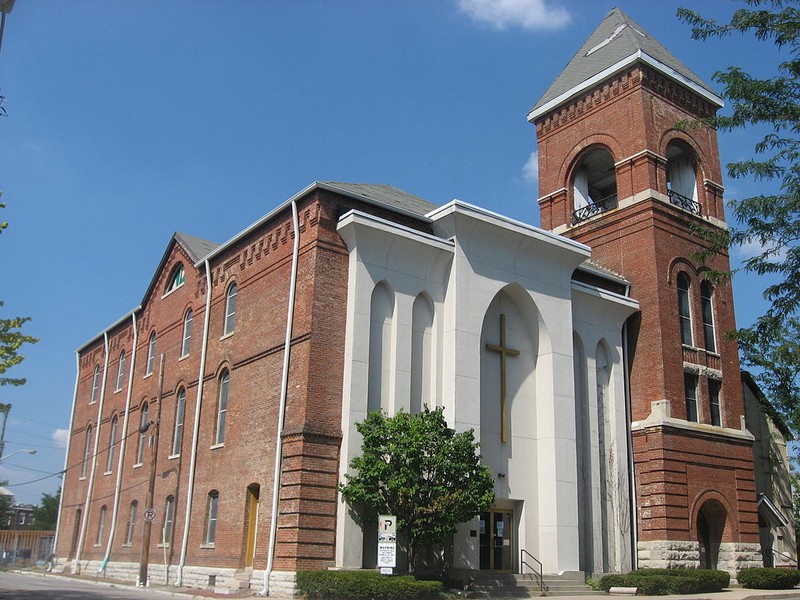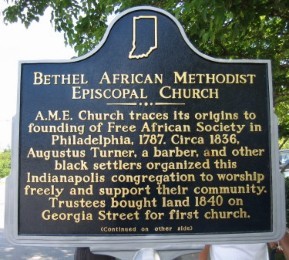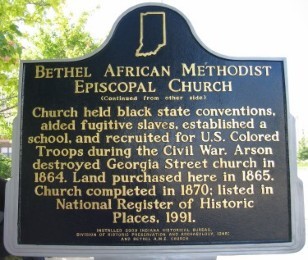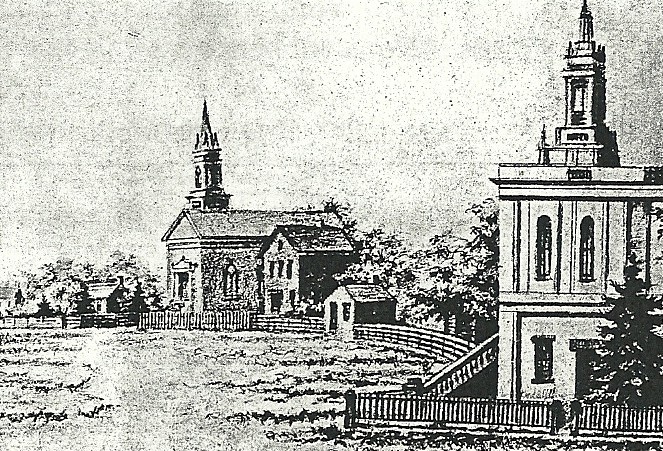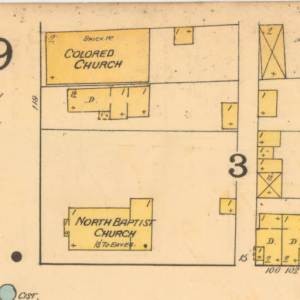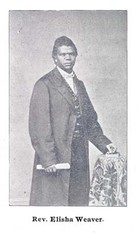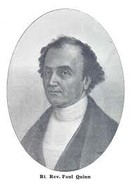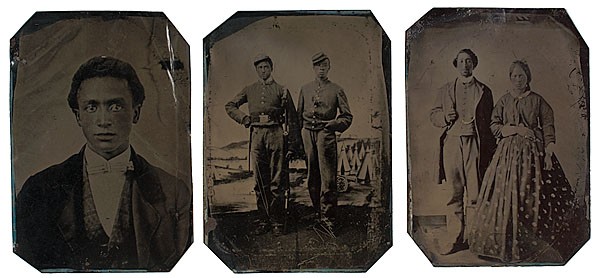Bethel A.M.E. Church was founded in Indianapolis in 1836. The congregation held services in a variety of homes and rented spaces prior to 1857, when the congregation built their own structure. The congregation sponsored a school, promoted the abolition of slavery, and even assisted efforts to support runaway slaves. During the Civil War, the congregation also supported efforts to recruit African American soldiers for the Union. Many men of the congregation served in the 28th Regiment of Colored Troops (28th Regiment USCT of Indiana). Unfortunately, during the same year of the 28th's formation (1864), the church was destroyed by arson. In 1867, the church purchased this lot and built the current church which was completed in 1869 and expanded in later years. This structure is the oldest African American church in the city and region. Throughout the 20th century, the church was active in numerous campaigns to promote equality and civil rights.
Bethel is Indianapolis's oldest African American church and has served the community since before the Civil War. The church was founded in 1836 by a group of African American Methodists. Members built a small church building on Georgia Street in between the Central Canal and Senate Avenue five years later. In 1857 members purchased Christ Episcopal Church and moved the building to their church's site on Georgia Street. The role of Bethel AME Church, which was originally known as the Indianapolis Station AME, grew along with the Black population of the city.
Founded by William Paul Quinn and Augustus Turner in 1836, the church was first known as "Indianapolis Station." The first meetings were held in Quinn's log cabin. In 1841, a modest house of worship was constructed. The congregation had grown to 100 by 1848 and became active in the antislavery movement. The congregation supported the Underground Railroad, providing protection to slaves en route to Canada.
That Black population made up approximately less than 3 percent of the total population in Indianapolis before the Civil War. Out of the total population of 1,338,710 in the state of Indiana in 1860, only 11,428 were African American. As the Civil War continued, the number of African Americans coming to Indianapolis from the South as well as rural areas around the state grew. The congregation's vocal support of the abolitionist movement led to a racially-motivated crime, as an arsonist destroyed the church in 1864. The congregation rebuilt the church in 1867.
Bethel AME Church members purchased a lot on West Vermont Street in 1867 for the construction of a new church building. By 1869 members had approved the name Bethel and moved to the new building here. The new place of worship also became a place for social activism as well as a venue for organizing and implementing services in the Black community. Those services included providing money, clothing, and temporary lodging to African Americans immigrating to the city from the South after the Civil War.
Bethel AME Church continued to be an important thread in the fabric of the Black community located to the northwest of Indianapolis's downtown area during the twentieth century, functioning as a space of racial solidarity and fulfilling a role that was interwoven throughout civil rights struggles and community outreach services for African Americans in the city. The church also served as a venue for the organization of local associations that were instrumental in the push to achieve better housing, education, and equal rights for African Americans. Both the Indianapolis NAACP chapter and Indiana State Federation of Colored Woman's Clubs were established at Bethel.
Members renovated the church building and adjoining parsonage in 1974 in order to make more space for outreach activities. Bethel AME Church was listed on the National Register of Historic Places in 1991. It is the only African-American church building in Indianapolis to receive that recognition.
Indianapolis's oldest African-American church is still active, occupying the same site it did in 1869. However, due to money issues and failure in fundraising, the congregation will soon move to a new building whilst the lot has been sold to a hotel development company. As of now, what will happen to the 1869 building is unknown. The state Historical Marker for Bethel AME Church, which is located across from the building on West Vermont Street, was dedicated on Saturday, June 20, 2009. The church is also a member of the Indianapolis Congregation Action Network (IndyCan) and has served as headquarters for IndyCan's Mass Transit Campaign since 2013.
Hale, Michelle D. "Bethel African Methodist Episcopal (AME) Church." In The Encyclopedia of Indianapolis, ed. David J. Bodenhamer and Robert G. Barrows, 318-319. Bloomington: Indiana University Press, 1994; Warren, Stanley. "The Bethel African Methodist Episcopal Church." Traces (Summer 2007): 32–36.
Thornbrough, Emma Lou. "African-Americans." In The Encyclopedia of Indianapolis, ed. David J. Bodenhamer and Robert G. Barrows, 5-14. Bloomington: Indiana University Press, 1994.
"Forged Through Fire: Bethel AME Church, Indianapolis Station AME Church, 1836-1869." Accessed July 7, 2014. http://forgedthroughfire.wordpress.com/
"Colored Immigrants in Indiana: Their Character and Location." The Indianapolis Leader, January 24, 1880. Pages 1-2. Accessed July 7, 2914. https://newspapers.library.in.gov/
Hale, Michelle D. "Bethel African Methodist Episcopal (AME) Church." In The Encyclopedia of Indianapolis, ed. David J. Bodenhamer and Robert G. Barrows, 318-319. Bloomington: Indiana University Press, 1994; Bethel A.M.E. Church, Indianapolis, Indiana. Interviews by Melissa Burlock, 18–21 July 2013. Audio recordings, IUPUI Special Collections and Archives, e-Archives, https://archives.iupui.edu/handle/2450/6956/browse?type=dateissued
Indiana Historical Bureau. "June 20, 2009 – Bethel African Methodist Episcopal Church." http://www.in.gov/history/BethelDed.htm
Grady, Carey A., Senior Pastor of Bethel A.M.E. Church. Phone conversation with writer, 14 July 2014; NUVO Editors. "IndyCAN heralds mass transit bill passage." Accessed July 14, 2014. http://www.nuvo.net/indianapolis/indycan-heralds-mass-transit-bill-passage/Content?oid=2784803#.UyJoWeddUQY ; "Bethel Cathedral." "Archived copy". Archived from the original.
"Aboard the Underground Railroad, Bethel A.M.E. Church". National Park Service.
